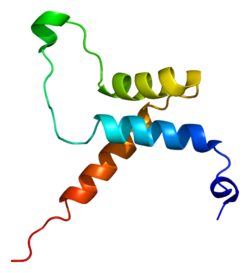
Summary
Transcriptional enhancer factor TEF-5 is a protein that in humans is encoded by the TEAD3 gene.[5][6][7]
| TEAD3 | |||||||||||||||||||||||||||||||||||||||||||||||||||
|---|---|---|---|---|---|---|---|---|---|---|---|---|---|---|---|---|---|---|---|---|---|---|---|---|---|---|---|---|---|---|---|---|---|---|---|---|---|---|---|---|---|---|---|---|---|---|---|---|---|---|---|
 | |||||||||||||||||||||||||||||||||||||||||||||||||||
| |||||||||||||||||||||||||||||||||||||||||||||||||||
| Identifiers | |||||||||||||||||||||||||||||||||||||||||||||||||||
| Aliases | TEAD3, DTEF-1, ETFR-1, TEAD-3, TEAD5, TEF-5, TEF5, TEA domain transcription factor 3 | ||||||||||||||||||||||||||||||||||||||||||||||||||
| External IDs | OMIM: 603170 MGI: 109241 HomoloGene: 81821 GeneCards: TEAD3 | ||||||||||||||||||||||||||||||||||||||||||||||||||
| |||||||||||||||||||||||||||||||||||||||||||||||||||
| |||||||||||||||||||||||||||||||||||||||||||||||||||
| |||||||||||||||||||||||||||||||||||||||||||||||||||
| |||||||||||||||||||||||||||||||||||||||||||||||||||
| |||||||||||||||||||||||||||||||||||||||||||||||||||
| Wikidata | |||||||||||||||||||||||||||||||||||||||||||||||||||
| |||||||||||||||||||||||||||||||||||||||||||||||||||
Function edit
This gene product is a member of the transcriptional enhancer factor (TEF) family of transcription factors, which contain the TEA/ATTS DNA-binding domain.[8] Members of the family in mammals are TEAD1, TEAD2, TEAD3, TEAD4. Transcriptional coregulators, such as WWTR1 (TAZ) bind to these transcription factors. TEAD3 is predominantly expressed in the placenta and is involved in the transactivation of the chorionic somatomammotropin-B gene enhancer. It is expressed in nervous system and muscle in fish embryos.[9] Translation of this protein is initiated at a non-AUG (AUA) start codon.[7]
References edit
- ^ a b c GRCh38: Ensembl release 89: ENSG00000007866 – Ensembl, May 2017
- ^ a b c GRCm38: Ensembl release 89: ENSMUSG00000002249 – Ensembl, May 2017
- ^ "Human PubMed Reference:". National Center for Biotechnology Information, U.S. National Library of Medicine.
- ^ "Mouse PubMed Reference:". National Center for Biotechnology Information, U.S. National Library of Medicine.
- ^ Jacquemin P, Depetris D, Mattei MG, Martial JA, Davidson I (Jan 1999). "Localization of human transcription factor TEF-4 and TEF-5 (TEAD2, TEAD3) genes to chromosomes 19q13.3 and 6p21.2 using fluorescence in situ hybridization and radiation hybrid analysis". Genomics. 55 (1): 127–9. doi:10.1006/geno.1998.5628. hdl:2268/13836. PMID 9889009.
- ^ Jacquemin P, Martial JA, Davidson I (May 1997). "Human TEF-5 is preferentially expressed in placenta and binds to multiple functional elements of the human chorionic somatomammotropin-B gene enhancer". The Journal of Biological Chemistry. 272 (20): 12928–37. doi:10.1074/jbc.272.20.12928. PMID 9148898.
- ^ a b "Entrez Gene: TEAD3 TEA domain family member 3".
- ^ Bürglin, TR (Jul 1991). "The TEA domain: a novel, highly conserved DNA-binding motif". Cell. 66 (1): 11–12. doi:10.1016/0092-8674(91)90132-I. PMID 2070413. S2CID 2819591.
- ^ Mann CJ, Osborn DP, Hughes SM (Oct 2007). "Vestigial-like-2b (VITO-1b) and Tead-3a (Tef-5a) expression in zebrafish skeletal muscle, brain and notochord". Gene Expression Patterns. 7 (8): 827–36. doi:10.1016/j.modgep.2007.08.001. PMC 3360971. PMID 17916448.
Further reading edit
- Jiang SW, Wu K, Eberhardt NL (Jun 1999). "Human placental TEF-5 transactivates the human chorionic somatomammotropin gene enhancer". Molecular Endocrinology. 13 (6): 879–89. doi:10.1210/mend.13.6.0288. PMID 10379887.
- Vaudin P, Delanoue R, Davidson I, Silber J, Zider A (Nov 1999). "TONDU (TDU), a novel human protein related to the product of vestigial (vg) gene of Drosophila melanogaster interacts with vertebrate TEF factors and substitutes for Vg function in wing formation". Development. 126 (21): 4807–16. doi:10.1242/dev.126.21.4807. PMID 10518497.
- Vassilev A, Kaneko KJ, Shu H, Zhao Y, DePamphilis ML (May 2001). "TEAD/TEF transcription factors utilize the activation domain of YAP65, a Src/Yes-associated protein localized in the cytoplasm". Genes & Development. 15 (10): 1229–41. doi:10.1101/gad.888601. PMC 313800. PMID 11358867.
- Maeda T, Mazzulli JR, Farrance IK, Stewart AF (Jul 2002). "Mouse DTEF-1 (ETFR-1, TEF-5) is a transcriptional activator in alpha 1-adrenergic agonist-stimulated cardiac myocytes". The Journal of Biological Chemistry. 277 (27): 24346–52. doi:10.1074/jbc.M201171200. PMID 11986313.
- Peng L, Huang Y, Jin F, Jiang SW, Payne AH (Aug 2004). "Transcription enhancer factor-5 and a GATA-like protein determine placental-specific expression of the Type I human 3beta-hydroxysteroid dehydrogenase gene, HSD3B1". Molecular Endocrinology. 18 (8): 2049–60. doi:10.1210/me.2004-0028. PMC 3273420. PMID 15131259.
External links edit
- TEAD3+protein,+human at the U.S. National Library of Medicine Medical Subject Headings (MeSH)







